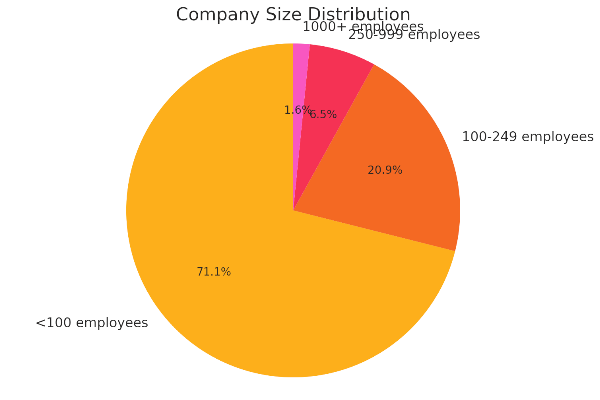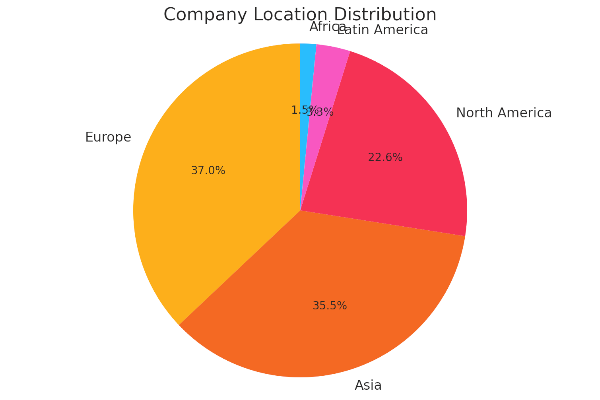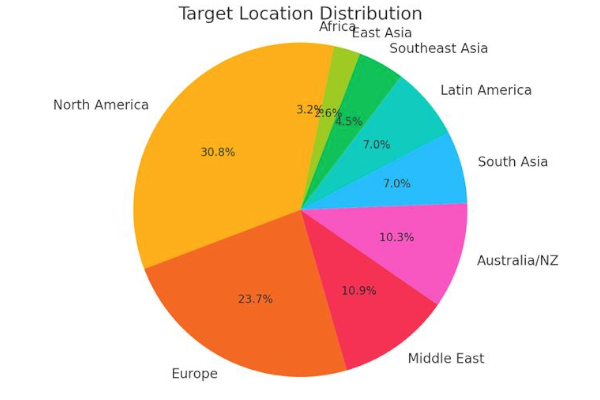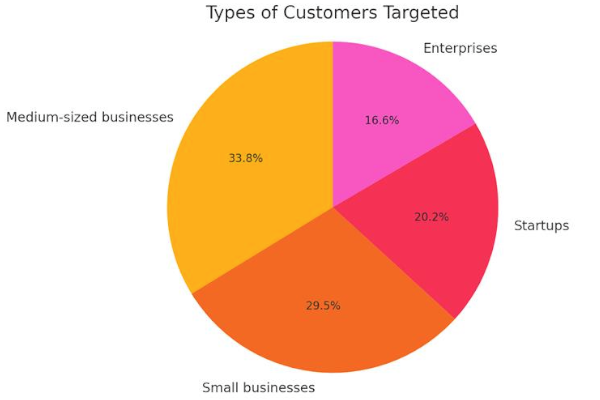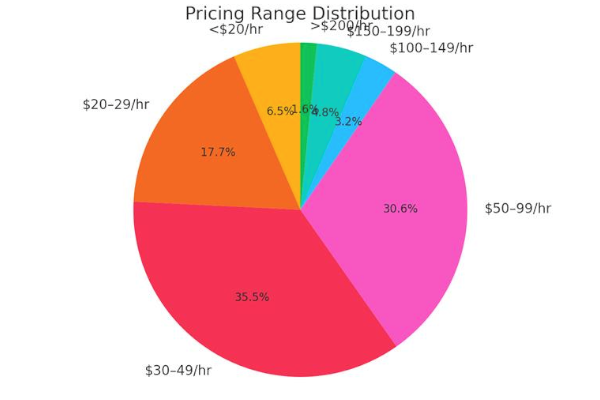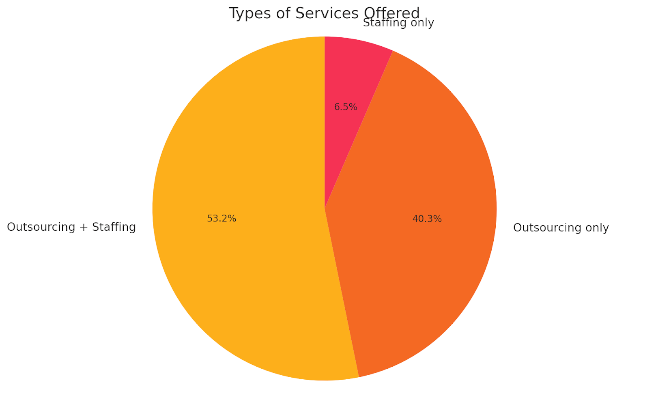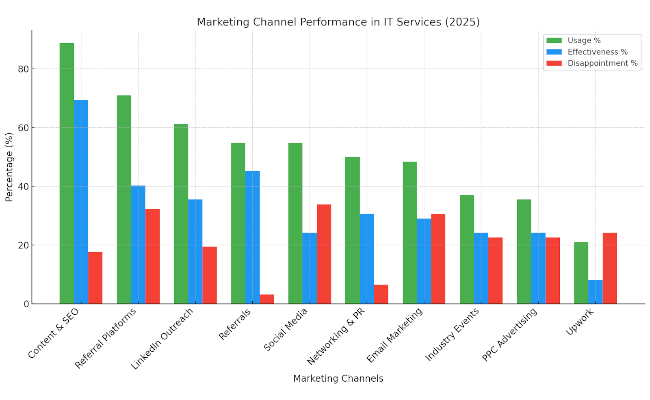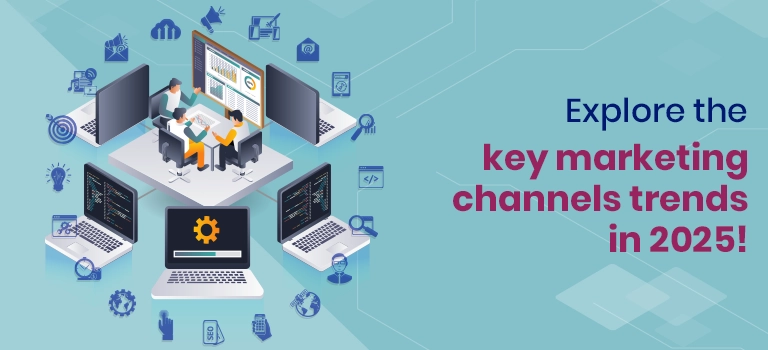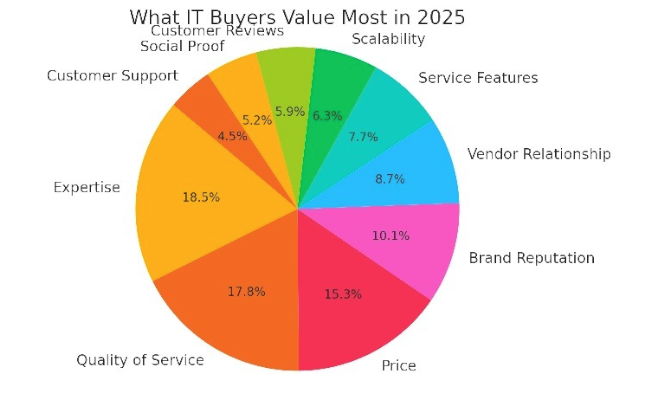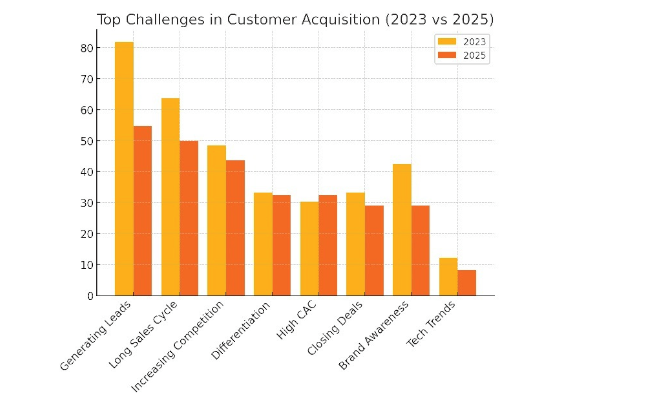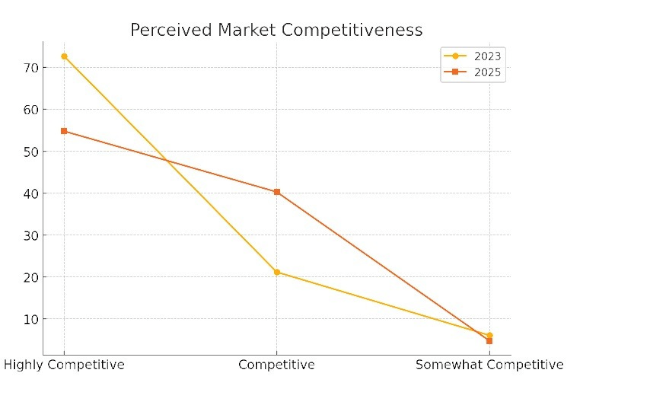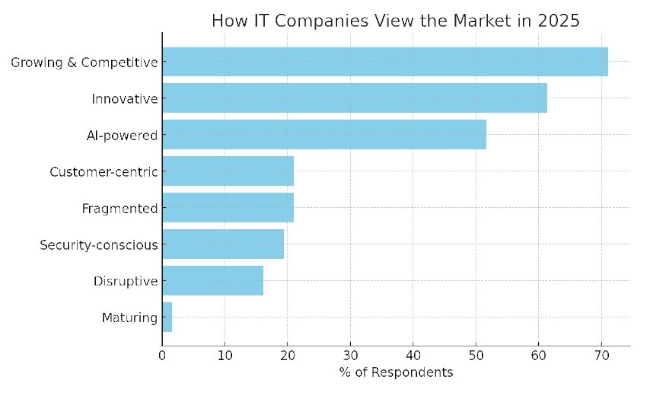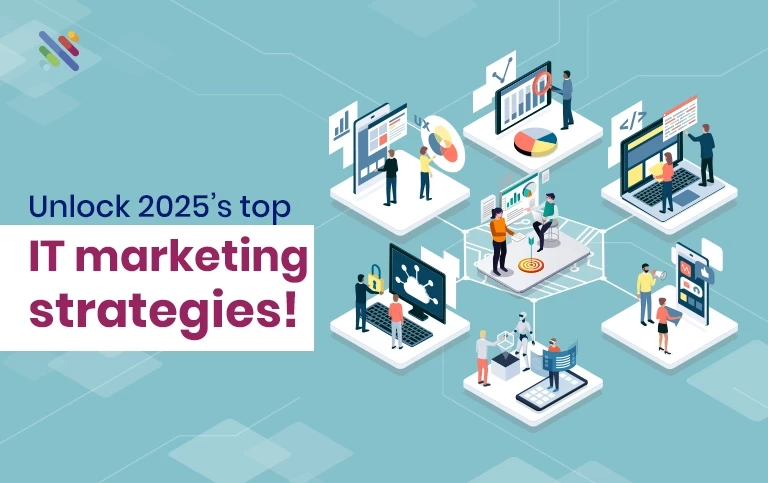
In 2025, the IT services sector is growing more than ever, though in 2024 it is projected to reach a stunning runaway of 1.67 trillion dollars in comparison to 1.48 trillion in 2023 (Statista, 2024). Along with this exponential growth of business, there is a great urgency associated with IT companies learning to become successful in the new, revolutionizing marketing channels for IT services in 2025. In such a saturated market, which is dependent upon digital communications, traditional advertising models are not effective. Those who embrace the implementation of AI in marketing, investments in data-driven marketing, and use the best marketing channels for IT companies, such as content marketing, social media, automation, and highly targeted paid campaigns, will be the winners in the SEO industry.
To assist IT companies in streamlining their marketing strategies for IT services in 2025, Netclues analyzes how the most effective marketing channels companies in the IT industry are deploying to drive business efficiency in the modern digital age. Based on the findings of the recent survey and real-world performance data, this report presents the most efficient marketing channels and those that fall short of user expectations; it also identifies marketing channels that are seen as future-forward investments that companies will deploy.
Key Findings
- Three-fourths of IT businesses say that content marketing is their most successful technique.
- Around 63 percent of firms are already embracing IT service marketing automation in an effort to simplify data nurturing and client retention.
- LinkedIn marketing services topped the B2B social media channels with 56 percent, and this is followed closely by Facebook marketing services.
- It is observed that 45 percent of companies increased their budget for SEO strategies targeting IT companies, with long-term ROI as one of the primary motivating factors.
This in-depth analysis is founded on the experiences of global players, ranging from small businesses to established companies with a geographical spread in North America, Europe, Asia-Pacific, and the Middle East. Having an IT marketing manager or being a provider of digital marketing services, or being a decision-maker of an IT firm, you will make sound decisions in 2025 and beyond, following this guide!
Participants Overview
Sixty-two IT service providers participated in our 2025 survey, which provided a broad perspective on the use of marketing channels across various companies. Organizations spread internationally, covering Europe, Asia, North America, Latin America, and Africa, thus displaying various market strategies that correspond to regional customers' needs and preferences.
Company Size
- Small firms (<100 employees) sway the majority with 71.5 percent of the respondents owing to the dominance of smaller providers in marketing plans in IT.
- Mid-sized (100-249 employees) has 21, which means that IT service businesses have scaled.
- The bigger companies (250-999 employees) represent 6.5 percent, and the enterprise (> 1,000 employees) 1.6 percent.
This highlights the fact that SMBs are the primary purchasers of marketing services, as evidenced by the landscape research on SMEs, which revealed that 90 percent of businesses worldwide are SMEs.
Company Location
- Europe wins by having 38.3 percent, with major contributions by Poland (11.3 percent), Ukraine (6.5 percent), and other EU members.
- Asia at 36.7 percent, mostly due to India (24.2 percent), and then Pakistan, the UAE (5 percent), and Southeast Asia.
- North America pays 23.4 percent (USA 16.1 percent, Canada 6.5 percent).
- There are 3.4 groups of Latin America and 1.6 in Africa (through Egypt).
This regional marriage is the typical cost-quality paradigm double-headed coin, with Asians emphasising cost efficiency and Europeans and Americans prioritising quality and innovation
Target Location
The companies have stated that they have been targeting the following markets:
- North America, 77.4 percent
- Europe- 59.7 percent.
- Middle East 27.4 percent
- Australia/New Zealand 25.8%
- South Asia/Latin America 17.7 percent each
- Southeast Asia: 11.3 %
- East Asia 6.5 percent East Asia - 6.5 percent
- Africa - 8.1 percent
These findings suggest that North America and Europe will be the primary regions for marketing IT services in 2025, as supported by regional business growth statistics in the technology market. For example, the European business software and services market contributes 25.1 percent to the global technology market.
Types of Customers
- Medium-sized businesses – targeted by 88.7% of respondents
- Small businesses – 77.4%
- Startups – 53.2%
- Enterprises – 43.5%
It is an example of high interest in SMBs, as it aligns with international outsourcing patterns: 37% of small companies outsource IT services.
Price Range
Hourly rates reported:
- <$20 – 6.5%
- $20–29 – 17.7%
- $30–49 – 35.5% (largest group)
- $50–99 – 30.6%
- $100–149 – 3.2%
- $150–199 – 4.8%
- >$200 – 1.6%
The resulting structure of tiered pricing is consistent with marketing IT budgets worldwide: middle-level providers (those generating between $30 and $99 per hour) offer the best compromise between price and quality.
Types of Services
Companies most commonly offered the following:
- Outsourcing + Staffing – 53.2%
- Outsourcing only – 40.3%
- Staffing only – 6.5%
This demonstrates a high demand for turnkey services that combine talent and project management, aligning with broader trends in the growth of IT outsourcing.
Marketing Channels
With the IT services industry becoming largely saturated and competitive, it is important to understand the best marketing channels to use to ensure the growth of companies keen on growth. Insights supported with data predict a certain trend, namely, using value-driven and trust-based marketing strategies that can be measured in ROI this year. Now, we can divide the two marketing channels that are driving IT companies ahead, and the ones that are lagging behind.
Primary Marketing Channels in 2025
Marketing Channel | Usage Rate (2025) | Effectiveness Rating | Disappointment Rate |
Content Marketing & SEO | 88.7% | 69.4% | 17.7% |
Referral Platforms | 71.0% | 40.3% | 32.3% |
LinkedIn Outreach | 61.3% | 35.5% | 19.4% |
Referrals | 54.8% | 45.2% | 3.2% |
Social Media Marketing | 54.8% | 24.2% | 33.9% |
Networking & PR | 50.0% | 30.6% | 6.5% |
Email Marketing | 48.4% | 29.0% | 30.6% |
Industry Events | 37.1% | 24.2% | 22.6% |
PPC Advertising | 35.5% | 24.2% | 22.6% |
Upwork | 21.0% | 8.1% | 24.2% |
1. Content Marketing and SEO – The Cornerstone Strategy
The most widely applied channel among IT service firms is content marketing and SEO, as 88.7% of firms rely on them. IT companies need to cultivate organic visibility and trust, and they can do that through high-quality blog content and technical whitepapers, case studies, and landing pages with superior SEO.
But after 17.7 percent are dissatisfied, the results depend on how the strategies are put through and the competition.
Tip: Topical authority, EEAT (Expertise, Experience, Authoritativeness, Trustworthiness), and schema implementation are good to be in the lead.
2. Referrals & Referral Platforms – The Trust Factor
Seventy-one percent of IT providers use referral platforms such as GoodFirms and Clutch. Although these websites are beneficial in promoting reviews and previous work, 32.3 percent are unsatisfied, and this is probably due to the high listing fees and low quality of leads.
Conversely, direct reference from customers is as bright as its efficiency, with a probability of 45.2 percent and only 3.2 percent of dissatisfactions; therefore, it is the most trusted communication and a consistent channel of communication.
Pro Strategy: Create an organized referral program based on CRM triggers and the reward loop.
3. LinkedIn Outreach & Networking/PR – For Targeted B2B Engagement
Although 61.3 percent use LinkedIn as the preferred B2B channel to access the decision-makers. But a small number, 35.5 percent, only deemed it very effective. The main offenders are saturation, automation fatigue, and inadequate personalization.
In the meantime, networking and PR, with an increasing rate of usage of 50 percent, offer only 6.5 percent disappointment, and thus, this service is valuable in trust-based lead generation.
Integrate: Use LinkedIn automation tools (e.g., PhantomBuster, Expandi) cleverly to eliminate spam.
4. Email Marketing – Classic, Yet Challenged
48.4 percent take advantage of email marketing; it provides one-on-one nurturing, but deals with the issues of deliverability and opening rates. 30.6 percent of the corporations say that they feel dissatisfied; this is caused by issues such as hygiene, irrelevance of content, or spam traps.
Pro Tip: Personalized drip campaigns with segmentation and the help of AI, such as Mailmodo or Constant Contact, will achieve improved results.
5. Social Media Marketing – Broad Reach, Narrow Returns
Although 54.8 percent of firms were adopting it, 33.9 percent of IT companies were not satisfied with it, primarily due to the loss of organic reach and a lack of accurate B2B targeting. IT consumers tend to bypass digital platforms such as Facebook and Instagram to cut costs. The best platforms to promote thought leadership and case studies are LinkedIn and YouTube.
Data Point: Organic reach on Facebook declined to 2.2% in 2025 (Hootsuite Social Trends Report).
Alternative: Reallocate funding to LinkedIn Video Ads or Reddit niche circuits, where it is possible to target with more precision.
6. PPC Advertising – Quick Wins with Costly Consequences
Whereas the use of PPC increased by 11.3 points (24.2 percent to 35.5 percent), its effectiveness (24.2 percent) has not been measured, and disappointment has stayed at 22.6 percent. As the price per click has gone up in conjunction with stricter privacy policies, the returns on paid advertisements are becoming lower every day, and unless campaigns are very narrow, they do not pay off.
Employ the use of AI in IT marketing: Employ ad platforms that are set up with AI, like Google Performance Max and Meta AI Ads, where you can implement iterative targeting.
7. Upwork & Industry Events – Declining ROI
The lowest effectiveness percentage (8.1%) was observed within Upwork, and nearly half of the dissatisfaction rates were the highest (24.2%). Freelancer-based services can no longer be trusted as a suitable source of client acquisition by the well-established IT companies.
In the meantime, industry events, although they provide brand exposure, yield a low return on investment (ROI) due to high travel costs and low conversion rates within the industry.
Alternative: See what a virtual summit/webinars, gated content and lead gen look like.
Strategic Recommendations for 2025 and Beyond
- Double Down Content + SEO: It is both highly effective and somewhat disappointing, yet remains the safest long-term bet.
- Invest in Trusted Channels: investing in recommendations and PR generates a predictable ROI at the lowest rate of dissatisfaction.
- Reevaluate LinkedIn and Referral Platforms: Determine ROI, personalize outreach and abandon non-converting platforms.
- Experiment Smarter Using Paid Advertising: No more blanket advertising with AI targeting and niche PPC (pay-per-click).
- Clean Up Social media and Email strategies: Emphasis on quality vs. quantity. Maximize on segmentation and timing.
Key Trends in Marketing Channels
2025 will be a critical year for firms offering IT services in terms of structuring their marketing activities. According to new surveys and B2B marketing exemplar figures provided by resources such as Clutch, GoodFirms, and the State of Marketing Report by HubSpot, the IT industry is no longer relying on broad-based outreach; the means are rather ROI-oriented and relationship-based marketing communications. We will consider some significant trend changes throughout this development.
Shifts in Primary Channel Usage
Increased Adoption
1. PPC Advertising
Usage: +11.3 pts (from 24.2% in 2023 to 35.5% in 2025)
Despite its low effectiveness level (24.2%), PPC continues to gain popularity. Its quick capacity to create leads, even when the cost of acquisition increases, is what makes it appealing to IT firms in the short run, especially those providing services like Mobile App Development, Cloud Services, or AI Integration.
Why? Personalized advertisements based on AI (e.g., Google Performance Max) are making the algorithms better.
2. Promotion and PR
Usage: +7.6 pts (from 42.4% to 50.0%)
This new emphasis on relationship marketing, leadership ideas and networking among the executive positions reveals that the IT service companies are concerned with their brand name and their credibility. Particularly with B2B IT service companies, this sales channel is vital since commerce often demands confidence and certainty in long sales cycles.
3. SEO and Content Marketing
Usage: +3.9 pts (from 84.8% to 88.7%)
The focus on content remains the primary concept in IT marketing. The use of AI tools, such as Surfer SEO, Jasper, and Semrush, has introduced marketers to comprehensive content with greater specificity, enhancing their control over keywords and focus areas.
The principles of SEO applied to IT businesses remain based on the enriched content comprising of experience and search engine optimization of zero clicks.
Decreased Adoption
1. Referral Platforms
Usage: -13.8 pts (from 84.8% to 71.0%)
The platforms that were once popular due to their ability to help develop credibility, such as Clutch or GoodFirms, are also experiencing a decline in demand. The 32.3% rate of dissatisfaction indicates that fluctuations in the quality of leads and excessive listing fees are causing providers to shift to their own or direct channels.
2. Social Media Marketing and referrals
Usage: -8.8 pts per (63.6 % to 54.8 %)
The decline in organic reach and viewer exhaustion on social media sites, including Facebook and Instagram, has exposed numerous organisations to the temptation to allocate funds to other channels. Additionally, referrals that are still considered trusted are more challenging to scale in 2025.
The marketing of IT companies on social media needs to shift to specialised networks and influencer collaboration.
3. Email Marketing (-6.1 pts) and Industry Events (-2.3 pts)
Objective oversaturation and lack of activity have forced companies to clamp down on email campaigns. On the same note, face-to-face events also had a low ROI, likely due to increased travel expenses and reduced participation in such events following the pandemic.
Changes in Disappointment Rates
Rising Disappointment
Channel | Disappointment Rate Increase (2023→2025) |
Social Media Marketing | +18.7 pts (from 15.2% to 33.9%) |
Referral Platforms | +1.96 pts |
Industry Events | +1.38 pts |
The first choice for underperformance is Social Media Marketing. The engagement engine that once held all the promise is now ailing due to a change in algorithm, content burnout, and a weakness in conversion rates (B2B).
The referral platforms and events were also subject to mild increases in dissatisfaction as their usage decreased.
Decreased Disappointment
Channel | Disappointment Rate Drop (2023→2025) |
Networking and PR | -8.7 pts (15.2% to 6.5%) |
Email Marketing | -5.75 pts |
Content & SEO | -3.46 pts |
Referrals | -2.87 pts |
PPC Advertising | -1.62 pts |
There was a significant decline in dissatisfaction in the fields of networking and PR, which became a powerhouse of trust. With more selective IT buyers, deals are more personal than ever before, delivered through a personal relationship and credibility.
The decline of Email Marketing is understandable because companies that were not successful simply left the channel, reducing the unsatisfied part.
Content and SEO were strong, and satisfaction was slightly improved as the match improved between AI and search improved.
Overall Insights & Strategic Implications
- ROI over Reach: IT companies are abandoning the broad-reach channels (e.g., social media) in favor of those where ROI is clear and measurable (e.g., SEO, PR, PPC).
- Trust is a Crucial Asset: Referral-based routes and PR remain effective because there is no alternative to trust or credibility in B2B decision-making.
- AI-Intelligent Content & Advertisements: Companies that use AI-based tools in automating the marketing of IT services have increased chances of enhancing targeting, conversion, and lowering disappointment rates of traditional digital methods.
- Fading of Pay-to-play platforms: Although referral platforms exist in large numbers, this is an indicator of a decline in the concept of pay-to-play platforms, as people warm up to the idea of paying to be seen rather than paying to be reviewed.
IT marketing budget
Factors that influence purchase decisions
With the current state of IT services before 2025, it is necessary to understand important issues that can drive buyer behavior, market dynamics, and marketing investments to gain success. So, what are the primary forces influencing demand in this highly competitive and tech-savvy environment?
What are the Influences in the Purchase Decisions of IT Services?
According to a multi-agency survey conducted in 2025 (Clutch, GoodFirms, HubSpot), technical substance, brand credibility, and value are the three most important areas to IT buyers:
Decision Factor | % of Respondents Citing It (2025) |
Expertise | 85.5% |
Quality of Service | 82.3% |
Price | 71.0% |
Brand Reputation | 46.8% |
Vendor Relationship | 40.3% |
Service Features | 35.5% |
Scalability | 29.0% |
Customer Reviews | 27.4% |
Social Proof | 24.2% |
Customer Support | 21.0% |
Key Shifts from 2023 to 2025
Decrease in price actions: 87.9% (2023) to 71.0% (2025), indicating a value-over-cost transformation.
Brand value and experience are gaining momentum, representing the long-term value of trust and technical expertise.
Customer support and customer reviews drop significantly in their effectiveness, implying that they have become common sense rather than separators.
Strategic Move: To succeed in attracting buyers, IT companies must demonstrate certifications, niche skills, and relevant case studies that showcase their expertise.
Biggest Challenges in Attracting IT Services Clients in 2025
Amidst market growth, IT companies continue to face several barriers in their sales pipelines, particularly in generating quality leads and closing long sales.
Challenge | % of Respondents (2025) |
Generating Leads | 54.8% |
Long Sales Cycles | 50.0% |
Increasing Competition | 43.6% |
Differentiation | 32.3% |
High Customer Acquisition Costs | 32.3% |
Closing Deals | 29.0% |
Lack of Brand Awareness | 29.0% |
Keeping Up with Tech Trends | 8.1% |
The rate of lead generation also decreased dramatically, from 81.8 percent in 2023 to 54.8 percent in 2025, indicating a possible efficiency increase due to the marketing automation of IT services, SEO marketing, and selective outreach using LinkedIn Marketing Services.
Insight: Although lead generation has improved, the cost of converting them remains high, as CAC issues have increased slightly (+2 points). This highlights a mismatch in the efficiency of the top of the funnel and conversion at the bottom.
Current IT Market Landscape: Competitive but Growing
Based on the 2025 information, market pressure is still experienced by 95 percent of IT service companies, although there has been a clear shift from cutthroat to manageable.
Market Perception | 2025 | 2023 | Change |
Highly Competitive | 54.8% | 72.7% | ↓ 17.9 pts |
Competitive | 40.3% | 21.2% | ↑ 19.1 pts |
Somewhat Competitive | 4.8% | 6.1% | ↓ 1.3 pts |
Not Competitive | 0.0% | 0.0% | - |
The decreasing sentiment towards the statement of highly competitive players is attributed to the notion of having better market positioning and segmentation strategies, which is attributed to content marketing of IT services and the use of AI in IT marketing.
Recommendation: Emphasis should be on honing (USPs) and technical specialization to survive in a less competitive and more manageable market.
The Current State of the IT Services Market (2025)
The respondents' perception of the market's nature provides an image of a lively space driven by technology and full of opportunities to capitalise on.
Market Characteristic | % of Respondents (2025) |
Growing & Competitive | 71.0% |
Rapidly Changing & Innovative | 61.3% |
Data-driven & AI-powered | 51.6% |
Customer-centric & Outcome-driven | 21.0% |
Fragmented & Complex | 21.0% |
Security-conscious & Compliant | 19.4% |
Disruptive & Transformative | 16.1% |
Consolidating & Maturing | 1.6% |
The most prevalent adjectives indicate a growth-driven and innovation-intensive culture, which aligns with the high rate of adoption of AI tools, automation, and analytics platforms.
However, surprisingly, the customer-centric sentiment decreased to 21.0% (2025) compared to the previous year, 42.4% (2023). Tech enablement might have skipped over user experience.
2025 Marketing Plans
With an increasingly stabilizing but still competitive market situation in 2025, an organically developed need to work with marketing investments in IT services by IT providers 2025 proves to be more ROI-oriented and strategic. According to primary research and surveys conducted by services such as Statista, HubSpot's State of Marketing 2024, and the Demand Gen Report, several key future trends indicate that sustainable lead generation sources are gaining popularity.
Top Investment: Content Marketing & SEO (64.5%)
The most preferred marketing channels are content marketing and SEO, as 64.5 percent of IT services firms plan to invest significantly in these channels this year. The reason behind this surge is the long-term ROI and compound value of organic search, blog posts, white papers, and technical SEO.
HubSpot notes that companies that engage in regular blogging attract 55 percent more visitors to their websites, as well as 67 percent more leads, compared to companies that do not blog. The key to authority when it comes to B2B services, such as those in IT, is having valuable content that demonstrates expertise.
Pro Tip: They should present the case studies, thought leadership materials and optimise the keywords according to technical services and buyer intent.
LinkedIn Outreach (45.2%)
B2B is witnessing the prosperity of professional networking. The outreach on LinkedIn enjoys the second-highest use (45.2%) in investment, as IT firms increase their actions in acquiring leads, building relationships, and recruiting on the platform.
It has more than 1 billion users, and 65 million decision-makers have been identified (source: LinkedIn Business, 2024), making it a default tool for connecting with CTOs, CIOs, and others in mid-to-enterprise markets.
Netclues Insight: Personalized InMail automation to upgrade the cold outreach process and augment it with informative content will increase the reply rates and engagement in the pipeline.
PPC Advertising (41.9%)
PPC advertising is also known as pay-per-click (PPC) advertising because it is a common, quick-win channel; however, it has a lower measure of effectiveness (24.19%), compared to SEO. PPC is perceived by IT services providers as a means of instant visibility, even when launching new products or services, or exploring new markets.
Despite the negative returns, 41.9 percent of respondents would continue to run PPC campaigns using Google Ads, LinkedIn Ads, and industry-specific directories.
Caution: Pay particular attention to returns on campaigns. Social media platforms such as Google search have recorded an increase of CPCs by 12-18 percent YoY in keywords related to technology topics.
Industry Events and Exhibitions (40.3)
In-person marketing is gaining post-pandemic momentum. 40.3 percent of companies in the IT sector intend to invest in industry events, trade shows, and exhibitions to establish trust and long-term business relationships.
Although the figures show a 22.6% decrease in lead capture, which is inconsistent, these occasions are crucial for the marketer's positioning, brand awareness, and the enterprise's overall involvement.
Record booth material, interviews, and client conversations with the omnichannel repurposing idea of email, social, and blogs.
Referral Platforms and Directories (38.7%)
Referral websites such as Clutch, GoodFirms, or DesignRush are not out of the game yet, despite dissatisfaction levels of 32.3 percent, as 38.7 percent of companies intend to invest in them to achieve visibility among high-intent B2B purchasers.
Nevertheless, conversion rates should be observed because not every profile stroll gives actual leads.
Best Practice: Client testimonials, verified case studies, and rank-boosting reviews should be regularly updated.
Networking & PR (37.1%)
Relationship management and one-on-one networking never die. These channels have an impressive track record, with a 6.5% disappointment rate in delivering results that are better than those achieved through paid media.
They are particularly effective when it comes to relationship-based growth, especially when combined with CEO branding, appearances on tech podcasts, and media mentions.
Even the less popular email marketing and social media can come in handy as tools for nurturing and visibility when used appropriately. Freelance sites, such as Upwork, are at the bottom, indicating that they are not particularly helpful in scaling up IT service companies.
Top Threats Facing IT Services Providers in 2025
1. Economic Recession (64.5%)
Macroeconomic factors, as the highest-ranked threat, will continue to be associated with 64.5 percent of companies, highlighting the danger of a global economic slowdown, inflation, or direct withdrawal of funds that could affect consumer spending.
Nevertheless, the concern has reduced by 11.3 points compared to 75.8 percent in 2023 as people are more optimistic about the economy.
2. Anti-competitive Forces/ Cost Increase
- New market entrants are a concern, with 27.4 percent (a 9.2 percent increase over 2023).
- The increasing cost of labor declined to 27.4 percent (compared to 42.4 percent) to reflect increased predictability of the price.
- Customer churn (21.0%) and skills gaps (17.7%) have high levels and continue to rise, particularly due to rapid technological changes and the potential application of AI.
As an additional note, there is an increased precipitation of fears regarding the loss of key employees, dropping 27.3 percent in 2023 and reducing henceforth to a measly 4.8 percent in 2025.
Strategic Outlook for 2025
Rise of AI, SEO, and Hyper-Personalization
When an inquiry was made into new tactics:
- Almost half (43.5%) focus on SEO and content as the primary sources of generating leads.
- 29.0 % are implementing AI-based marketing to automate the sales cycle, scoring, and personalization.
- That 24.2 percent revolves around a rebound to social media, with an emphasis on influencer collaboration, short-form video, and B2B community interaction.
- A full 8.1 percent will experiment with less popular or recent strategies, such as using WhatsApp for Business or webinars relevant to a particular industry.
Conclusion: Reimagining IT Services Marketing in 2025
Navigating the changing and increasingly competitive environment, the 2025 forecast indicates a strategic shift in customer acquisition and IT company brand presence. Reflecting on the industry-wide knowledge and patterns, content marketing and SEO are the most reliable marketing channels to rely on for promoting IT services in 2025, supported by the ability to calculate ROI, generate leads over the long term, and establish buyer trust.
Although the use of social media marketing services, IT companies, and email marketing continues to serve as an assisting factor, such methods are being reinvented because of the turn towards personalization, automation, and the use of AI-enabled tools. One can observe the changes in IT marketing, especially within the field of AI, where companies are using automation to nurture their leads, do predictive analytics, and run highly personalized campaigns on numerous digital touchpoints.
Key insights from the analysis
- Content marketing for IT services is taking the lead, with 64.5 percent of companies prioritizing it, and it is relevant at both the awareness and conversion levels.
- Marketing on LinkedIn is becoming very necessary among the B2B IT companies that seek to connect with the decision-makers through professional and personalized communication.
- Paid advertising for IT companies, such as Google Ads and social PPC, provides short-term visibility; however, companies must streamline their expenditures towards achieving real ROI.
- Search engine optimization services for IT firms are no longer an option. They form the basis by ensuring that firms remain visible with an AI-empowered search ecosystem.
- Marketing automation for IT service marketing is on the rise, and some tools facilitate the automation of lead scoring, drip campaigns, and onboarding clients.
- With the increasing proportion of mobile-first experiences, particularly among SaaS products and app-driven IT solutions, the existence of mobile app marketing services is a testament to this trend.
Although not all channels are working as intended, such as generalized Facebook marketing services or basic processes of referrals, 2025 is a year of maturity in channel strategy. Data-driven, value-focused marketing strategies are helping IT service providers refine their online presence.
Notably, its perspective on the market is steadier than in 2023, and fewer providers mention a threatening factor like economic recession or the increase in labor costs. Scalability is, nevertheless, a challenge due to competition, a shortage of skills, and the cost of acquiring customers. This demands a more focused attention on differentiation, positioning, and investments in talent and automation.
Last-minute 2025 IT Marketer Retrospections
- Choose the best marketing channels for IT companies, using search engine optimization, content, LinkedIn, and PR to increase their long-term brand equity and pipeline.
- Find an agency that is results-driven in Digital Marketing Services and develop specific campaigns that match the industry requirements.
- Promote personalization through email, web, and social with marketing automation and AI-driven choices to improve the buyer experience.
- Tune up social media marketing efforts to re-engage audiences by venturing into storytelling, building relationships with influencers, and fostering a community around a niche.
- Remember to continuously review the developing tools and mediums so you can stay ahead of your competition and create effective spending.
In IT businesses, selecting the proper digital marketing for IT services will determine the success or failure of such adoption in the future to achieve growth in 2025 and beyond through successful and sustained implementation and performance analytics. As a startup or an enterprise, finding the proper match will guide you in leveraging this growing stage, such as Netclues, a skilled Digital Marketing Services Provider.
Quick Answers: 2025 IT Services Marketing FAQ
Q. What is the best marketing channel for IT companies in 2025?
A. Content marketing and SEO are the most effective in 2025. They help IT firms build authority, get found on Google, and earn trust over time.
Q. How are IT companies using LinkedIn for marketing?
A. IT companies use LinkedIn outreach and ads to connect with B2B decision-makers. Personalized messages and thought leadership content work best.
Q. Is PPC worth it for IT services in 2025?
A. Yes—but only with niche targeting and AI-powered campaigns like Google Performance Max. Otherwise, costs can outweigh returns.
Q. What role does AI play in IT marketing today?
A. AI is used for content creation, automation, ad optimization, and lead scoring—helping IT firms market smarter, not harder.
Q. Are referrals still a good lead source for IT services?
A. Yes. Direct client referrals are trusted and convert well, especially in B2B IT services. Referral platforms are less reliable now.
Q. Which regions are IT firms targeting in 2025?
A. Most IT companies focus on North America, Europe, and the Middle East, where tech demand and ROI are highest.
Q. What do IT buyers care most about?
A. Buyers value expertise, service quality, and brand reputation more than just price. Trust is a top priority.
Q. What’s the biggest marketing challenge for IT firms?
A. The biggest challenge is generating qualified leads and converting them through long sales cycles.
Q. Should IT companies still invest in email marketing?
A. Yes, if it's personalized and automated. Generic email blasts are outdated, but segmented drip campaigns still perform well.
Q. What’s the #1 marketing tip for IT firms in 2025?
A. Double down on content and SEO. It builds long-term visibility, drives inbound leads, and improves other channels.



